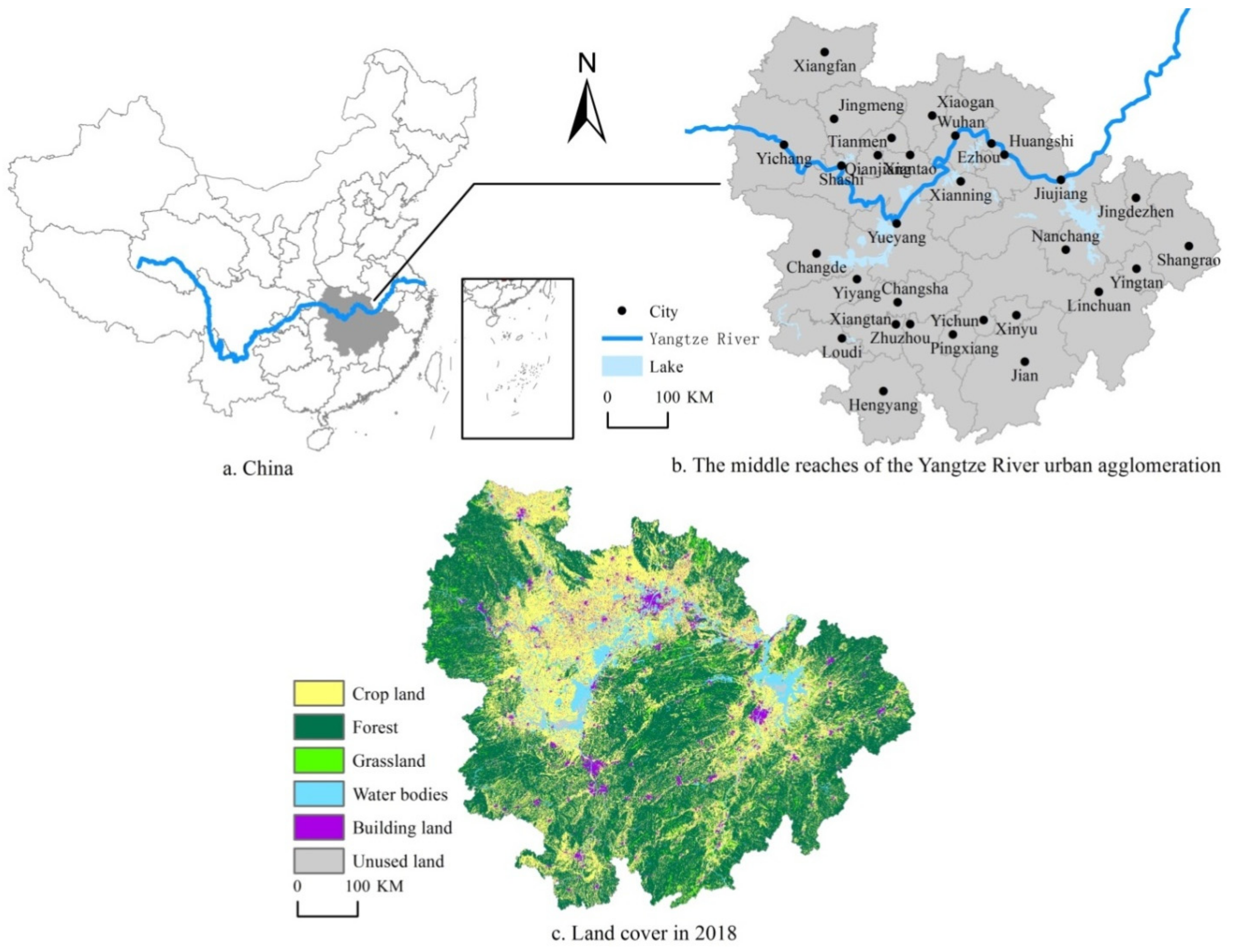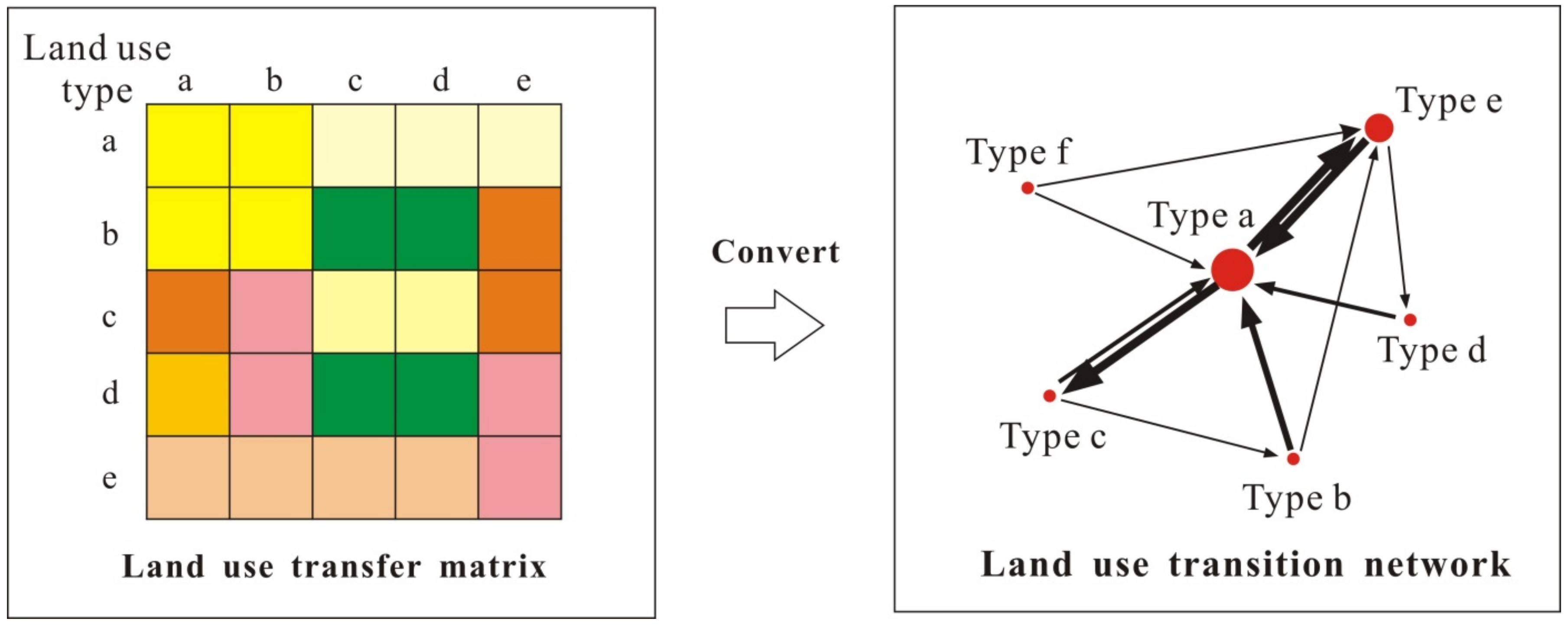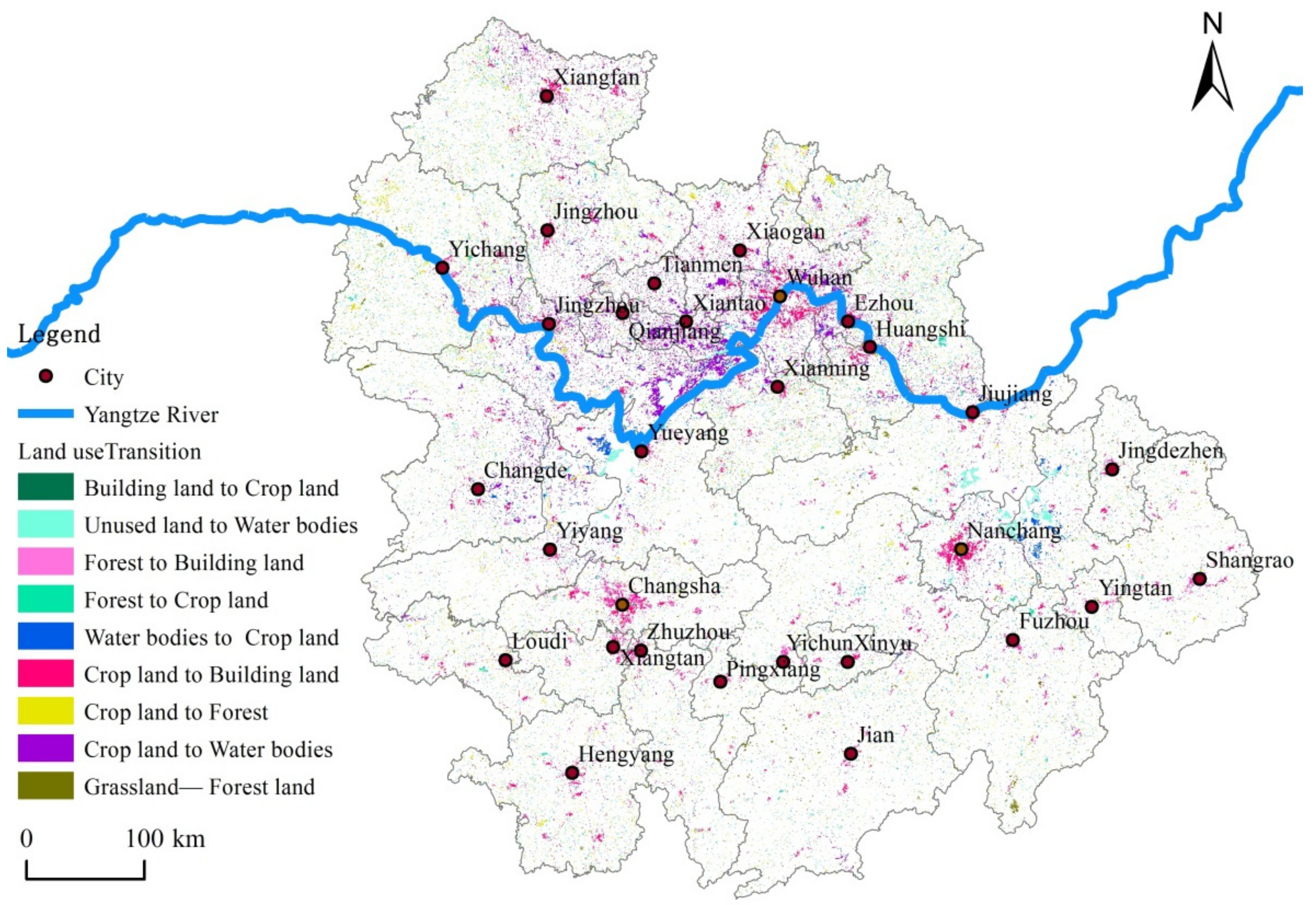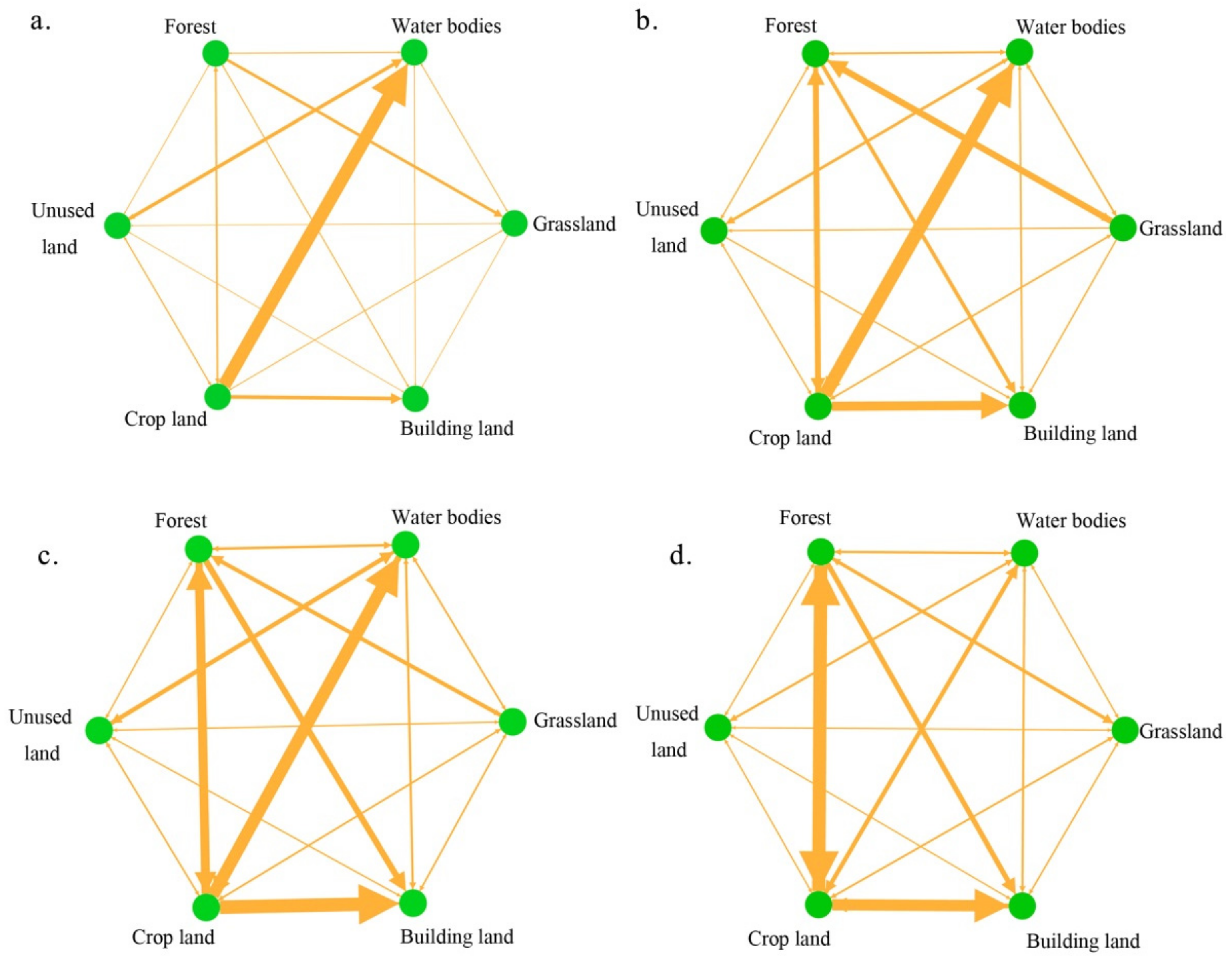Spatio-Temporal Dynamic and Structural Characteristics of Land Use/Cover Change Based on a Complex Network: A Case Study of the Middle Reaches of Yangtze River Urban Agglomeration
Abstract
:1. Introduction
2. Materials and Methods
2.1. Study Area
2.2. Data Source
2.3. Methods
2.3.1. Land Use Transfer Matrix
2.3.2. Land Use Dynamic Degree
2.3.3. A Complex Network-Based Approach to Land Use Structure Analysis
3. Results
3.1. Overall Evolution and Regional Differences of Land Use/Cover Change
3.1.1. General Evolutionary Characteristics
3.1.2. Land Use/Cover Change in the Core Areas
3.2. Structural Characteristics of Land Use/Cover Change
3.2.1. The Recognition of Key Land Types
3.2.2. The Recognition of Main Land Use Change Pattern
4. Discussion
4.1. Driving Factors of Land Use Change in MRYRUA
4.2. Structural Characteristics and Driving Factors of Land Use Change in MRYRUA
4.3. Land Use Optimization Measures
4.4. Limitations and Future Directions of the Study
5. Conclusions
Author Contributions
Funding
Institutional Review Board Statement
Informed Consent Statement
Data Availability Statement
Conflicts of Interest
References
- Turner, B.L., II; Lambin, E.F.; Reenberg, A. The emergence of land change science for global environmental change and sustainability. Proc. Natl. Acad. Sci. USA 2007, 104, 20666–20671. [Google Scholar] [CrossRef] [PubMed] [Green Version]
- Lian, L.; Li, B.; Chen, Y.; Chu, C.; Qin, Y. Quantifying the effects of luccs on local temperatures, precipitation, and wind using the wrf model. Environ. Monit. Assess. 2017, 189, 501.501–501.511. [Google Scholar] [CrossRef] [PubMed]
- Ye, C.; Chen, M.; Duan, J.; Yang, D. Uneven development, urbanization and production of space in the middle-scale region based on the case of Jiangsu province, China. Habitat Int. 2017, 66, 106–116. [Google Scholar] [CrossRef]
- Li, H.; Peng, J.; Liu, Y.; Hu, Y.n. Urbanization impact on landscape patterns in Beijing city, China: A spatial heterogeneity perspective. Ecol. Indic. 2017, 82, 50–60. [Google Scholar] [CrossRef]
- Chen, R.; Ye, C.; Cai, Y.; Xing, X.; Chen, Q. The impact of rural out-migration on land use transition in China: Past, present and trend. Land Use Policy 2014, 40, 101–110. [Google Scholar] [CrossRef]
- Yu, A.T.W.; Wu, Y.; Zheng, B.; Zhang, X.; Shen, L. Identifying risk factors of urban-rural conflict in urbanization: A case of China. Habitat Int. 2014, 44, 177–185. [Google Scholar] [CrossRef]
- Chen, J. Rapid urbanization in China: A real challenge to soil protection and food security. Catena 2007, 69, 1–15. [Google Scholar] [CrossRef]
- Chen, M.; Liu, W.; Lu, D.; Chen, H.; Ye, C. Progress of China’s new-type urbanization construction since 2014: A preliminary assessment. Cities 2018, 78, 180–193. [Google Scholar] [CrossRef]
- Liu, D.; Cai, S. A spatial-temporal modeling approach to reconstructing land-cover change trajectories from multi-temporal satellite imagery. Ann. Assoc. Am. Geogr. 2012, 102, 1329–1347. [Google Scholar] [CrossRef]
- Liu, C.; Xu, Y.; Sun, P.; Huang, A.; Zheng, W. Land use change and its driving forces toward mutual conversion in Zhangjiakou city, a farming-pastoral ecotone in northern China. Environ. Monit. Assess. 2017, 189, 505. [Google Scholar] [CrossRef]
- Varga, O.G.; Pontius, R.G., Jr.; Szabo, Z.; Szabo, S. Effects of category aggregation on land change simulation based on corine land cover data. Remote Sens. 2020, 12, 1314. [Google Scholar] [CrossRef] [Green Version]
- He, J.; Huang, J.; Li, C. The evaluation for the impact of land use change on habitat quality: A joint contribution of cellular automata scenario simulation and habitat quality assessment model. Ecol. Model. 2017, 366, 58–67. [Google Scholar] [CrossRef]
- Zhang, W.; Chang, W.J.; Zhu, Z.C.; Hui, Z. Landscape ecological risk assessment of chinese coastal cities based on land use change. Appl. Geogr. 2020, 117, 102174. [Google Scholar] [CrossRef]
- Mishra, N.B.; Crews, K.A.; Okin, G.S. Relating spatial patterns of fractional land cover to savanna vegetation morphology using multi-scale remote sensing in the central kalahari. Int. J. Remote Sens. 2014, 35, 2082–2104. [Google Scholar] [CrossRef] [Green Version]
- Liu, J.; Deng, X. Progress of the research methodologies on the temporal and spatial process of lucc. Chin. Sci. Bull. 2010, 55, 1354–1362. [Google Scholar] [CrossRef]
- Chen, M.; Bai, Z.; Wang, Q.; Shi, Z. Habitat quality effect and driving mechanism of land use transitions: A case study of henan water source area of the middle route of the south-to-north water transfer project. Land 2021, 10, 796. [Google Scholar] [CrossRef]
- Ge, Y.; Hu, S.; Ren, Z.; Jia, Y.; Wang, J.; Liu, M.; Zhang, D.; Zhao, W.; Luo, Y.; Fu, Y.; et al. Mapping annual land use changes in China’s poverty-stricken areas from 2013 to 2018. Remote Sens. Environ. 2019, 232, 111285. [Google Scholar] [CrossRef]
- Aldwaik, S.Z.; Pontius, R.G., Jr. Intensity analysis to unify measurements of size and stationarity of land changes by interval, category, and transition. Landsc. Urban Plan. 2012, 106, 103–114. [Google Scholar] [CrossRef]
- Shoyama, K.; Braimoh, A.K. Analyzing about sixty years of land-cover change and associated landscape fragmentation in shiretoko peninsula, northern japan. Landsc. Urban Plan. 2011, 101, 22–29. [Google Scholar] [CrossRef]
- Mallinis, G.; Koutsias, N.; Arianoutsou, M. Monitoring land use/land cover transformations from 1945 to 2007 in two peri-urban mountainous areas of athens metropolitan area, greece. Sci. Total Environ. 2014, 490, 262–278. [Google Scholar] [CrossRef]
- Huang, J.; Pontius, R.G., Jr.; Li, Q.; Zhang, Y. Use of intensity analysis to link patterns with processes of land change from 1986 to 2007 in a coastal watershed of southeast China. Appl. Geogr. 2012, 34, 371–384. [Google Scholar] [CrossRef]
- Mansour, S.; Al-Belushi, M.; Al-Awadhi, T. Monitoring land use and land cover changes in the mountainous cities of oman using gis and ca-markov modelling techniques. Land Use Policy 2020, 91, 104414. [Google Scholar] [CrossRef]
- Wang, S.-Y.; Liu, J.-S.; Ma, T.-B. Dynamics and changes in spatial patterns of land use in Yellow River Basin, China. Land Use Policy 2010, 27, 313–323. [Google Scholar] [CrossRef]
- Lee, C.-L.; Huang, S.-L.; Chan, S.-L. Synthesis and spatial dynamics of socio-economic metabolism and land use change of taipei metropolitan region. Ecol. Model. 2009, 220, 2940–2959. [Google Scholar] [CrossRef]
- Lambin, E.F.; Meyfroidt, P. Land use transitions: Socio-ecological feedback versus socio-economic change. Land Use Policy 2010, 27, 108–118. [Google Scholar] [CrossRef]
- Li, T.; Long, H.; Liu, Y.; Tu, S. Multi-scale analysis of rural housing land transition under China’s rapid urbanization: The case of Bohai Rim. Habitat Int. 2015, 48, 227–238. [Google Scholar] [CrossRef]
- Mizutani, C. Construction of an analytical framework for polygon-based land use transition analyses. Comput. Environ. Urban Syst. 2012, 36, 270–280. [Google Scholar] [CrossRef]
- Long, H.; Zhang, Y.; Ma, L.; Tu, S. Land use transitions: Progress, challenges and prospects. Land 2021, 10, 903. [Google Scholar] [CrossRef]
- Liu, Y.; Long, H.; Li, T.; Tu, S. Land use transitions and their effects on water environment in Huang-Huai-Hai Plain, China. Land Use Policy 2015, 47, 293–301. [Google Scholar] [CrossRef]
- Long, H.; Qu, Y.; Tu, S.; Zhang, Y.; Jiang, Y. Development of land use transitions research in China. J. Geogr. Sci. 2020, 30, 1195–1214. [Google Scholar] [CrossRef]
- Zhou, J.; Hou, Q. Complex network-based research on the resilience of rural settlements in Sanshui watershed. Land 2021, 10, 1068. [Google Scholar] [CrossRef]
- Watts, D.J.; Strogatz, S.H. Collective dynamics of ‘small-world’ networks. Nature 1998, 393, 440–442. [Google Scholar] [CrossRef]
- Barabási, A.L.; Albert, R. Emergence of scaling in random networks. Science 1999, 286, 509–512. [Google Scholar] [CrossRef] [Green Version]
- Boccaletti, S.; Latora, V.; Moreno, Y.; Chavez, M.; Hwang, D.U. Complex networks: Structure and dynamics. Phys. Rep.-Rev. Sect. Phys. Lett. 2006, 424, 175–308. [Google Scholar] [CrossRef]
- Lao, X.; Zhang, X.; Shen, T.; Skitmore, M. Comparing China’s city transportation and economic networks. Cities 2016, 53, 43–50. [Google Scholar] [CrossRef] [Green Version]
- Fan, W.; Fong, D.K.C.; Li, G.; Law, R. Understanding clusters of tourist behavior associations using network analysis. Int. J. Hosp. Tour. Adm. 2021, 22, 502–523. [Google Scholar] [CrossRef]
- Tao, Q.; Li, R.; Wang, Y. Integrative effects among innovation network elements on innovation performance based on qca. Int. J. Serv. Technol. Manag. 2016, 22, 301–312. [Google Scholar] [CrossRef]
- Klerkx, L.; Aarts, N.; Leeuwis, C. Adaptive management in agricultural innovation systems: The interactions between innovation networks and their environment. Agric. Syst. 2010, 103, 390–400. [Google Scholar] [CrossRef]
- Zhang, M.; Wang, J.; Feng, Y. Temporal and spatial change of land use in a large-scale opencast coal mine area: A complex network approach. Land Use Policy 2019, 86, 375–386. [Google Scholar] [CrossRef]
- Zhang, B.; Yin, L.; Zhang, S.; Feng, C. Assessment on characteristics of lucc process based on complex network in Modern Yellow River Delta, Shandong Province of China. Earth Sci. Inform. 2016, 9, 83–93. [Google Scholar] [CrossRef]
- Joo, H.; Kim, H.S.; Kim, S.; Sivakumar, B. Complex networks and integrated centrality measure to assess the importance of streamflow stations in a River basin. J. Hydrol. 2021, 598, 126280. [Google Scholar] [CrossRef]
- Xiang, J.; Li, X.; Xiao, R.; Wang, Y. Effects of land use transition on ecological vulnerability in poverty-stricken mountainous areas of China: A complex network approach. J. Environ. Manag. 2021, 297, 113206. [Google Scholar] [CrossRef]
- Nystuen, J.D.; Dacey, M.F. A graph theory interpretation of nodal regions. Pap. Reg. Sci. Assoc. 1961, 7, 29–42. [Google Scholar] [CrossRef] [Green Version]
- Chao, D.; Chunliang, X.; Ye, W. Network structure of ‘space of flows’ in Jilin province based on telecommunication flows. Acta Geogr. Sin. 2014, 69, 510–519. [Google Scholar]





| Indicators | Formulas | Implication | Variable Interpretation |
|---|---|---|---|
| Out-degree | The larger the out-degree of land type i, the more area is transferred to other land types, the in-degree has the opposite meaning. The stronger the centrality index of a land type, the higher the status in the network. | i, j = 1, …, n: land use type; Sij: the area transferred from land type i to land type j; Sji: the area transferred from land type j to land type i; n: the number of nodes; bjk: the shortest path between node j and node k; bijk is the shortest path between node j and node k, which must pass through node i. | |
| In-degree | |||
| Centrality | |||
| Diffusion degree | If D > 1, the land belongs to the output land type; if D < 1, it belongs to the input land type; and if D = 1, the land type is balanced. | ||
| Betweenness centrality | The larger the node betweenness is, the greater the controlling power of the corresponding node. |
| Core Regions | All Land Transferred | Crop Land to Building Land | Forest to Building Land | |||
|---|---|---|---|---|---|---|
| km2 | % | km2 | % | km2 | % | |
| Urban agglomeration around Poyang Lake | 4878.9 | 8.6 | 980.0 | 1.7 | 392.4 | 0.7 |
| Wuhan Metropolitan Area | 8619.8 | 14.9 | 2274.9 | 3.9 | 298.9 | 0.5 |
| Ring of Chang-Zhu-Tan urban agglomeration | 7535.2 | 7.8 | 1398.6 | 1.4 | 988.3 | 1.0 |
| Land Use Type | Crop Land | Forest | Grassland | Water Bodies | Building Land | Unused Land | |
|---|---|---|---|---|---|---|---|
| Period I 1980–1990 | Cout | 27.32 | 6.19 | 1.19 | 5.52 | 0.12 | 5.57 |
| Cin | 5.48 | 2.51 | 4.20 | 25.46 | 5.62 | 2.65 | |
| D | 4.99 | 2.47 | 0.28 | 0.22 | 0.02 | 2.10 | |
| C | 32.80 | 8.70 | 5.39 | 30.98 | 5.73 | 8.21 | |
| B | 9.81 | 5.18 | 2.79 | 7.59 | 0.33 | 1.00 | |
| Period II 1990–2000 | Cout | 41.07 | 13.91 | 9.60 | 11.39 | 0.12 | 1.04 |
| Cin | 13.89 | 16.38 | 3.92 | 22.34 | 17.99 | 2.60 | |
| D | 2.96 | 0.85 | 2.45 | 0.51 | 0.01 | 0.40 | |
| C | 54.95 | 30.28 | 13.53 | 33.73 | 18.11 | 3.64 | |
| B | 8.93 | 7.28 | 0.58 | 8.38 | 0.19 | 0.08 | |
| Period III 2000–2010 | Cout | 51.64 | 20.99 | 6.43 | 14.45 | 3.35 | 5.50 |
| Cin | 20.95 | 18.37 | 2.30 | 26.43 | 30.09 | 4.23 | |
| D | 2.47 | 1.14 | 2.80 | 0.55 | 0.11 | 1.30 | |
| C | 72.59 | 39.36 | 8.73 | 40.87 | 33.44 | 9.74 | |
| B | 9.20 | 5.50 | 0.60 | 8.30 | 1.20 | 0.30 | |
| Period IV 2010–2018 | Cout | 42.74 | 31.44 | 3.36 | 8.78 | 7.42 | 1.79 |
| Cin | 31.33 | 24.21 | 4.54 | 8.97 | 24.73 | 1.76 | |
| D | 1.36 | 1.30 | 0.74 | 0.98 | 0.30 | 1.02 | |
| C | 74.07 | 55.65 | 7.90 | 17.74 | 32.15 | 3.55 | |
| B | 7.27 | 5.91 | 0.27 | 7.79 | 1.24 | 0.16 | |
| Output Land Type (D > 1) | Input Land Type (D < 1) | Balanced Land Type (D ≈ 1) | Core Land Type (C > 30) | Nodal Land Type (B > 5) | |
|---|---|---|---|---|---|
| Period I 1980–1990 | Crop land, Forest, Unused land | Grassland, Water bodies, Building land | None | Crop land, Water bodies | Crop land, Water bodies |
| Period II 1990–2000 | Crop land, Grassland | Water bodies, Building land, unused land | Forest | Crop land, Water bodies, Forest, Building land | Crop land, Water bodies, Forest |
| Period III 2000–2010 | Crop land, Grassland | Water bodies, Building land | Unused land | Crop land, Water bodies, Forest, Building land | Crop land, Water bodies, Forest |
| Period IV 2010–2018 | Crop land, Forest | Grassland, Building land | Water bodies | Crop land, Water bodies, Forest, Building land | Crop land, Water bodies, Forest |
| Transfer Directions | |||||||
|---|---|---|---|---|---|---|---|
| First transfer directions | Period I 1980–1990 | 14 | 21 | 32 | 41 | 51 | 64 |
| Period II 1990–2000 | 14 | 21 | 32 | 41 | 51 | 64 | |
| Period III 2000–2010 | 12 | 21 | 32 | 41 | 51 | 64 | |
| Period IV 2010–2018 | 12 | 21 | 32 | 41 | 51 | 64 | |
| Tendency land change pattern | 14/12, 21, 32, 41, 51, 64 | ||||||
| TOP5 transfer directions | Period I 1980–1990 | 14 | 15 | 64 | 23 | 41 | - |
| Period II 1990–2000 | 14 | 15 | 32 | 12 | 41 | - | |
| Period III 2000–2010 | 15 | 14 | 12 | 21 | 41 | - | |
| Period IV 2010–2018 | 21 | 12 | 15 | 25 | 51 | - | |
| Stable land use change pattern | 14, 15, 41, 12, 21 | ||||||
Publisher’s Note: MDPI stays neutral with regard to jurisdictional claims in published maps and institutional affiliations. |
© 2022 by the authors. Licensee MDPI, Basel, Switzerland. This article is an open access article distributed under the terms and conditions of the Creative Commons Attribution (CC BY) license (https://creativecommons.org/licenses/by/4.0/).
Share and Cite
Wang, Z.; Li, T.; Yang, S.; Zhong, D. Spatio-Temporal Dynamic and Structural Characteristics of Land Use/Cover Change Based on a Complex Network: A Case Study of the Middle Reaches of Yangtze River Urban Agglomeration. Sustainability 2022, 14, 6941. https://doi.org/10.3390/su14116941
Wang Z, Li T, Yang S, Zhong D. Spatio-Temporal Dynamic and Structural Characteristics of Land Use/Cover Change Based on a Complex Network: A Case Study of the Middle Reaches of Yangtze River Urban Agglomeration. Sustainability. 2022; 14(11):6941. https://doi.org/10.3390/su14116941
Chicago/Turabian StyleWang, Zhao, Tao Li, Shan Yang, and Daili Zhong. 2022. "Spatio-Temporal Dynamic and Structural Characteristics of Land Use/Cover Change Based on a Complex Network: A Case Study of the Middle Reaches of Yangtze River Urban Agglomeration" Sustainability 14, no. 11: 6941. https://doi.org/10.3390/su14116941
APA StyleWang, Z., Li, T., Yang, S., & Zhong, D. (2022). Spatio-Temporal Dynamic and Structural Characteristics of Land Use/Cover Change Based on a Complex Network: A Case Study of the Middle Reaches of Yangtze River Urban Agglomeration. Sustainability, 14(11), 6941. https://doi.org/10.3390/su14116941





